University Project: Quality Improvement in Hospitals & Palliative Care
VerifiedAdded on 2019/09/16
|6
|1437
|373
Project
AI Summary
This project focuses on quality improvement within a hospital setting, specifically targeting the enhancement of palliative care for terminally ill patients. The project emphasizes the importance of continuous quality improvement in healthcare to improve patient satisfaction and recovery. It outlines a program aimed at providing better end-of-life care, discussing the goals, evaluation methods, and necessary steps to achieve improved patient outcomes. The project highlights the benefits of palliative care, including pain management, emotional support for patients and families, and potential increased survival expectancy. It stresses the importance of effective communication between healthcare professionals, patients, and families, particularly in discussing sensitive topics related to end-of-life care. The project also addresses the need for staff training, cost-effectiveness, and the integration of palliative care into hospital practices, using references to support the discussed concepts.
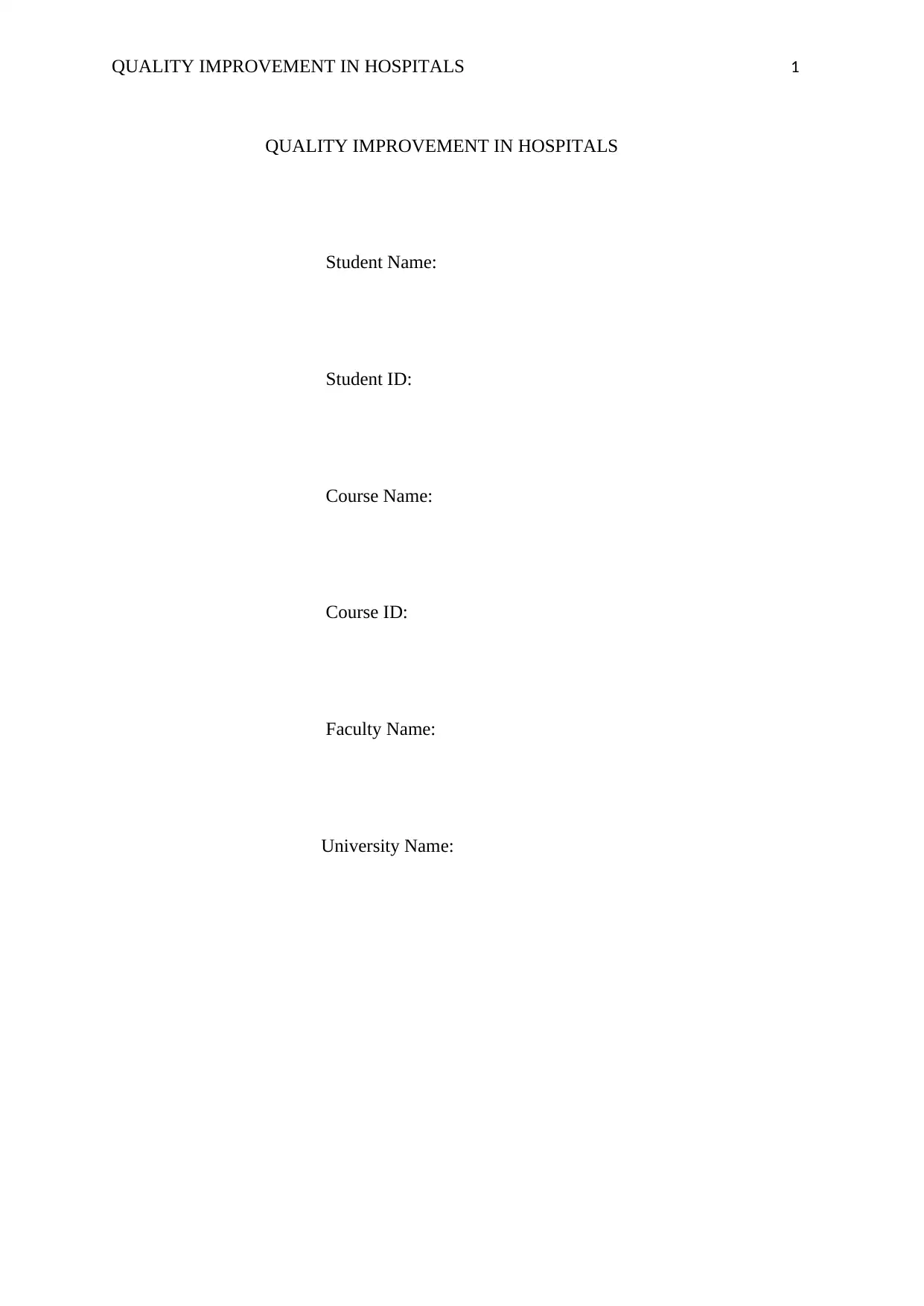
QUALITY IMPROVEMENT IN HOSPITALS 1
QUALITY IMPROVEMENT IN HOSPITALS
Student Name:
Student ID:
Course Name:
Course ID:
Faculty Name:
University Name:
QUALITY IMPROVEMENT IN HOSPITALS
Student Name:
Student ID:
Course Name:
Course ID:
Faculty Name:
University Name:
Paraphrase This Document
Need a fresh take? Get an instant paraphrase of this document with our AI Paraphraser
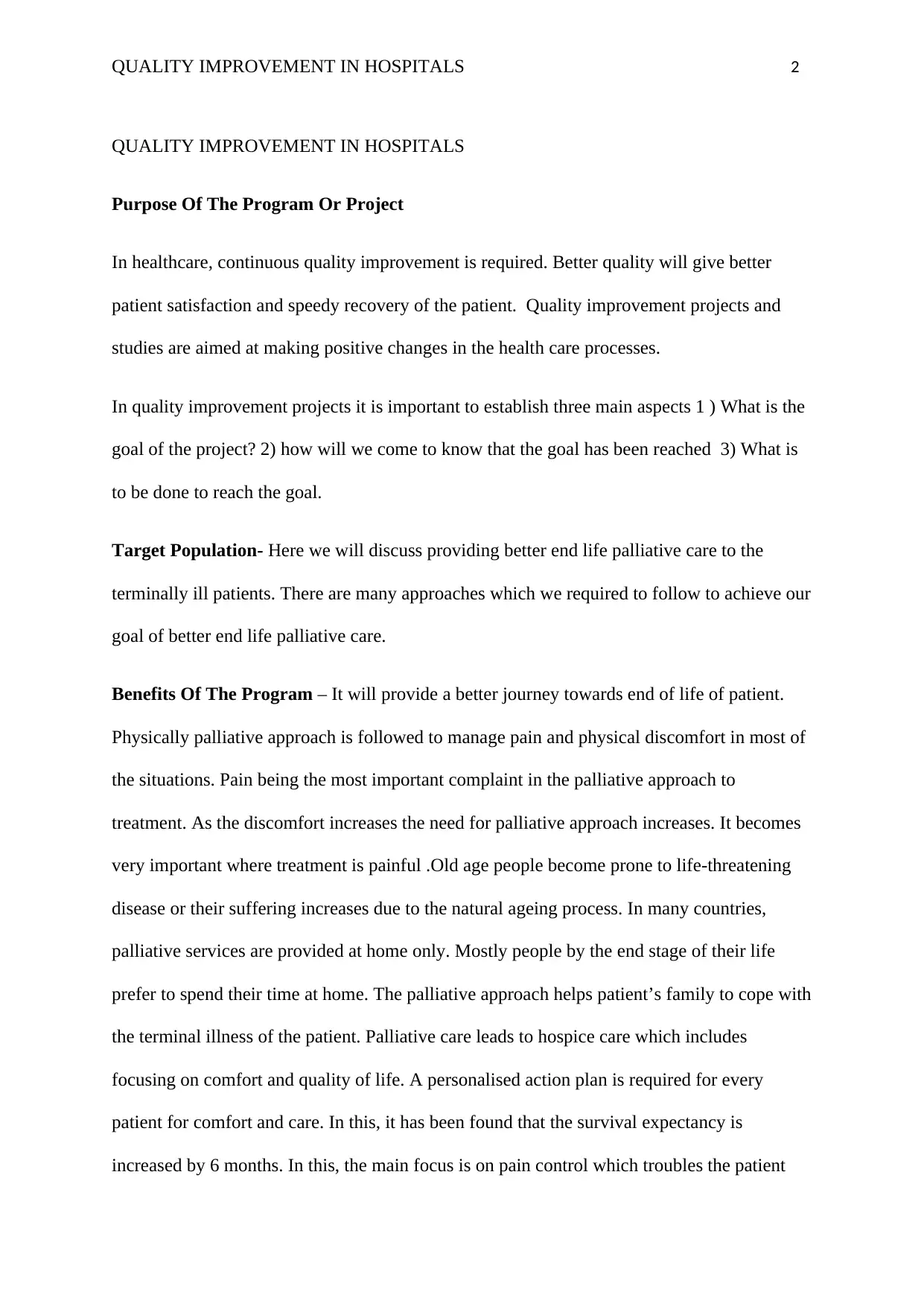
QUALITY IMPROVEMENT IN HOSPITALS 2
QUALITY IMPROVEMENT IN HOSPITALS
Purpose Of The Program Or Project
In healthcare, continuous quality improvement is required. Better quality will give better
patient satisfaction and speedy recovery of the patient. Quality improvement projects and
studies are aimed at making positive changes in the health care processes.
In quality improvement projects it is important to establish three main aspects 1 ) What is the
goal of the project? 2) how will we come to know that the goal has been reached 3) What is
to be done to reach the goal.
Target Population- Here we will discuss providing better end life palliative care to the
terminally ill patients. There are many approaches which we required to follow to achieve our
goal of better end life palliative care.
Benefits Of The Program – It will provide a better journey towards end of life of patient.
Physically palliative approach is followed to manage pain and physical discomfort in most of
the situations. Pain being the most important complaint in the palliative approach to
treatment. As the discomfort increases the need for palliative approach increases. It becomes
very important where treatment is painful .Old age people become prone to life-threatening
disease or their suffering increases due to the natural ageing process. In many countries,
palliative services are provided at home only. Mostly people by the end stage of their life
prefer to spend their time at home. The palliative approach helps patient’s family to cope with
the terminal illness of the patient. Palliative care leads to hospice care which includes
focusing on comfort and quality of life. A personalised action plan is required for every
patient for comfort and care. In this, it has been found that the survival expectancy is
increased by 6 months. In this, the main focus is on pain control which troubles the patient
QUALITY IMPROVEMENT IN HOSPITALS
Purpose Of The Program Or Project
In healthcare, continuous quality improvement is required. Better quality will give better
patient satisfaction and speedy recovery of the patient. Quality improvement projects and
studies are aimed at making positive changes in the health care processes.
In quality improvement projects it is important to establish three main aspects 1 ) What is the
goal of the project? 2) how will we come to know that the goal has been reached 3) What is
to be done to reach the goal.
Target Population- Here we will discuss providing better end life palliative care to the
terminally ill patients. There are many approaches which we required to follow to achieve our
goal of better end life palliative care.
Benefits Of The Program – It will provide a better journey towards end of life of patient.
Physically palliative approach is followed to manage pain and physical discomfort in most of
the situations. Pain being the most important complaint in the palliative approach to
treatment. As the discomfort increases the need for palliative approach increases. It becomes
very important where treatment is painful .Old age people become prone to life-threatening
disease or their suffering increases due to the natural ageing process. In many countries,
palliative services are provided at home only. Mostly people by the end stage of their life
prefer to spend their time at home. The palliative approach helps patient’s family to cope with
the terminal illness of the patient. Palliative care leads to hospice care which includes
focusing on comfort and quality of life. A personalised action plan is required for every
patient for comfort and care. In this, it has been found that the survival expectancy is
increased by 6 months. In this, the main focus is on pain control which troubles the patient
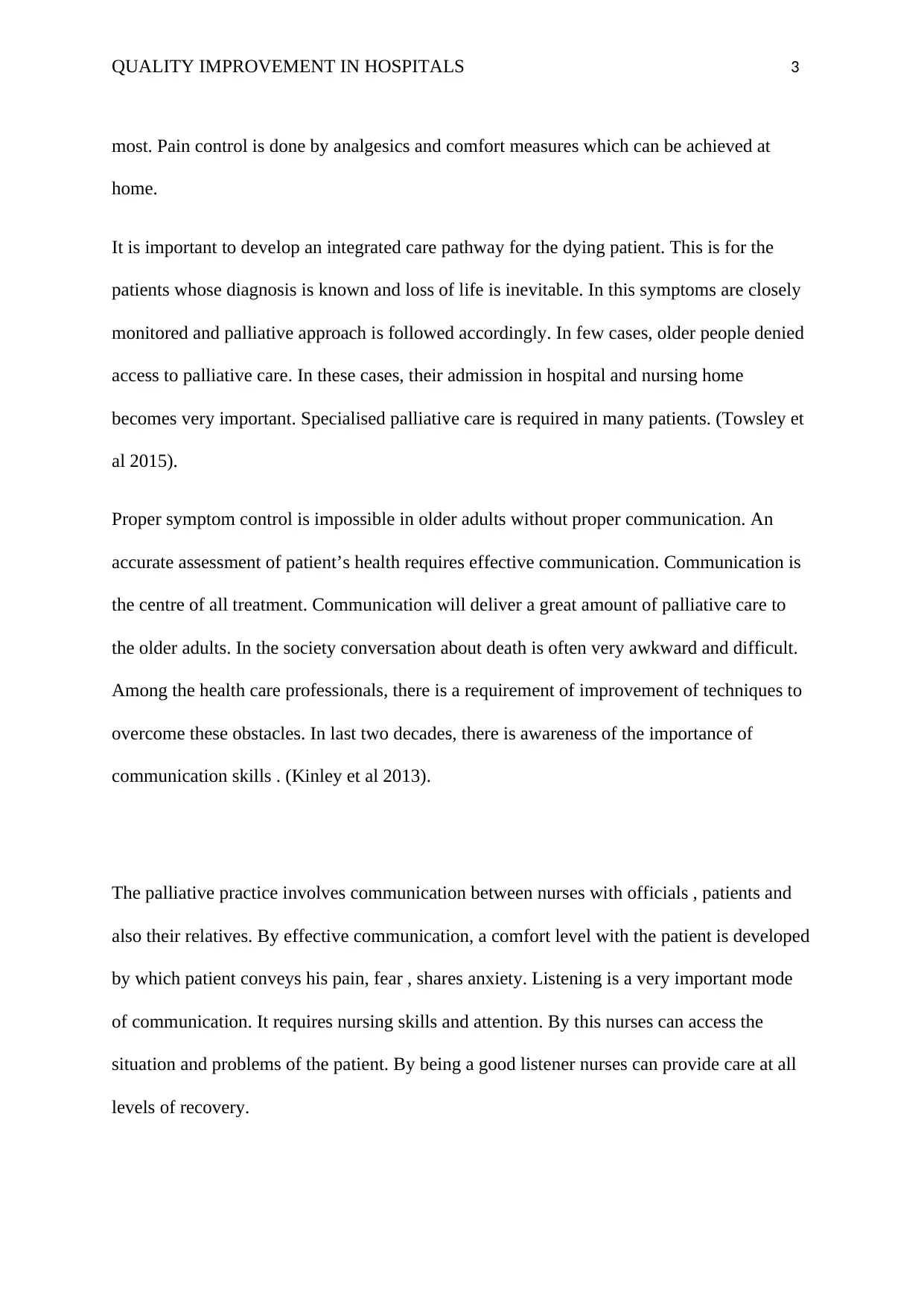
QUALITY IMPROVEMENT IN HOSPITALS 3
most. Pain control is done by analgesics and comfort measures which can be achieved at
home.
It is important to develop an integrated care pathway for the dying patient. This is for the
patients whose diagnosis is known and loss of life is inevitable. In this symptoms are closely
monitored and palliative approach is followed accordingly. In few cases, older people denied
access to palliative care. In these cases, their admission in hospital and nursing home
becomes very important. Specialised palliative care is required in many patients. (Towsley et
al 2015).
Proper symptom control is impossible in older adults without proper communication. An
accurate assessment of patient’s health requires effective communication. Communication is
the centre of all treatment. Communication will deliver a great amount of palliative care to
the older adults. In the society conversation about death is often very awkward and difficult.
Among the health care professionals, there is a requirement of improvement of techniques to
overcome these obstacles. In last two decades, there is awareness of the importance of
communication skills . (Kinley et al 2013).
The palliative practice involves communication between nurses with officials , patients and
also their relatives. By effective communication, a comfort level with the patient is developed
by which patient conveys his pain, fear , shares anxiety. Listening is a very important mode
of communication. It requires nursing skills and attention. By this nurses can access the
situation and problems of the patient. By being a good listener nurses can provide care at all
levels of recovery.
most. Pain control is done by analgesics and comfort measures which can be achieved at
home.
It is important to develop an integrated care pathway for the dying patient. This is for the
patients whose diagnosis is known and loss of life is inevitable. In this symptoms are closely
monitored and palliative approach is followed accordingly. In few cases, older people denied
access to palliative care. In these cases, their admission in hospital and nursing home
becomes very important. Specialised palliative care is required in many patients. (Towsley et
al 2015).
Proper symptom control is impossible in older adults without proper communication. An
accurate assessment of patient’s health requires effective communication. Communication is
the centre of all treatment. Communication will deliver a great amount of palliative care to
the older adults. In the society conversation about death is often very awkward and difficult.
Among the health care professionals, there is a requirement of improvement of techniques to
overcome these obstacles. In last two decades, there is awareness of the importance of
communication skills . (Kinley et al 2013).
The palliative practice involves communication between nurses with officials , patients and
also their relatives. By effective communication, a comfort level with the patient is developed
by which patient conveys his pain, fear , shares anxiety. Listening is a very important mode
of communication. It requires nursing skills and attention. By this nurses can access the
situation and problems of the patient. By being a good listener nurses can provide care at all
levels of recovery.
⊘ This is a preview!⊘
Do you want full access?
Subscribe today to unlock all pages.

Trusted by 1+ million students worldwide
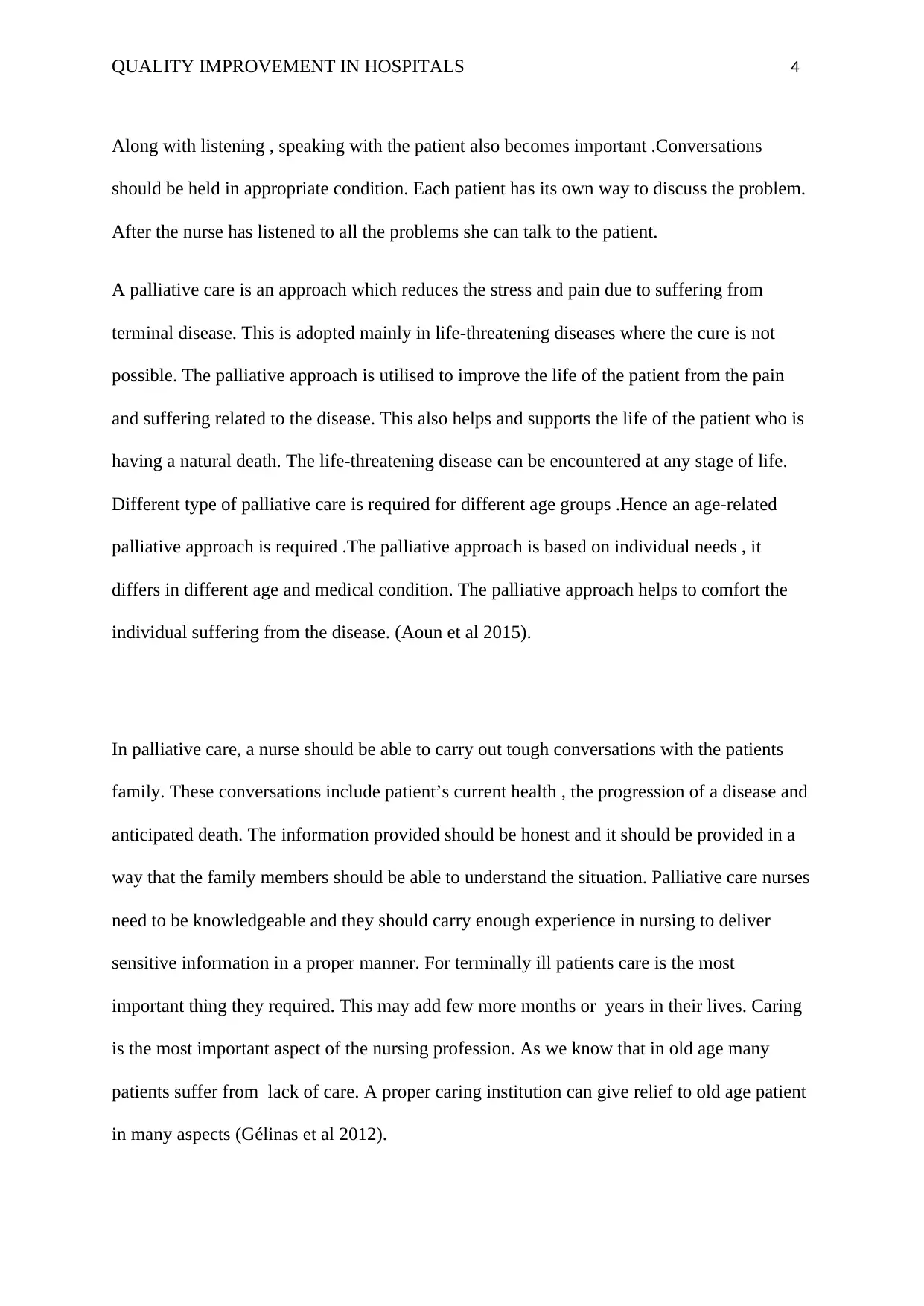
QUALITY IMPROVEMENT IN HOSPITALS 4
Along with listening , speaking with the patient also becomes important .Conversations
should be held in appropriate condition. Each patient has its own way to discuss the problem.
After the nurse has listened to all the problems she can talk to the patient.
A palliative care is an approach which reduces the stress and pain due to suffering from
terminal disease. This is adopted mainly in life-threatening diseases where the cure is not
possible. The palliative approach is utilised to improve the life of the patient from the pain
and suffering related to the disease. This also helps and supports the life of the patient who is
having a natural death. The life-threatening disease can be encountered at any stage of life.
Different type of palliative care is required for different age groups .Hence an age-related
palliative approach is required .The palliative approach is based on individual needs , it
differs in different age and medical condition. The palliative approach helps to comfort the
individual suffering from the disease. (Aoun et al 2015).
In palliative care, a nurse should be able to carry out tough conversations with the patients
family. These conversations include patient’s current health , the progression of a disease and
anticipated death. The information provided should be honest and it should be provided in a
way that the family members should be able to understand the situation. Palliative care nurses
need to be knowledgeable and they should carry enough experience in nursing to deliver
sensitive information in a proper manner. For terminally ill patients care is the most
important thing they required. This may add few more months or years in their lives. Caring
is the most important aspect of the nursing profession. As we know that in old age many
patients suffer from lack of care. A proper caring institution can give relief to old age patient
in many aspects (Gélinas et al 2012).
Along with listening , speaking with the patient also becomes important .Conversations
should be held in appropriate condition. Each patient has its own way to discuss the problem.
After the nurse has listened to all the problems she can talk to the patient.
A palliative care is an approach which reduces the stress and pain due to suffering from
terminal disease. This is adopted mainly in life-threatening diseases where the cure is not
possible. The palliative approach is utilised to improve the life of the patient from the pain
and suffering related to the disease. This also helps and supports the life of the patient who is
having a natural death. The life-threatening disease can be encountered at any stage of life.
Different type of palliative care is required for different age groups .Hence an age-related
palliative approach is required .The palliative approach is based on individual needs , it
differs in different age and medical condition. The palliative approach helps to comfort the
individual suffering from the disease. (Aoun et al 2015).
In palliative care, a nurse should be able to carry out tough conversations with the patients
family. These conversations include patient’s current health , the progression of a disease and
anticipated death. The information provided should be honest and it should be provided in a
way that the family members should be able to understand the situation. Palliative care nurses
need to be knowledgeable and they should carry enough experience in nursing to deliver
sensitive information in a proper manner. For terminally ill patients care is the most
important thing they required. This may add few more months or years in their lives. Caring
is the most important aspect of the nursing profession. As we know that in old age many
patients suffer from lack of care. A proper caring institution can give relief to old age patient
in many aspects (Gélinas et al 2012).
Paraphrase This Document
Need a fresh take? Get an instant paraphrase of this document with our AI Paraphraser
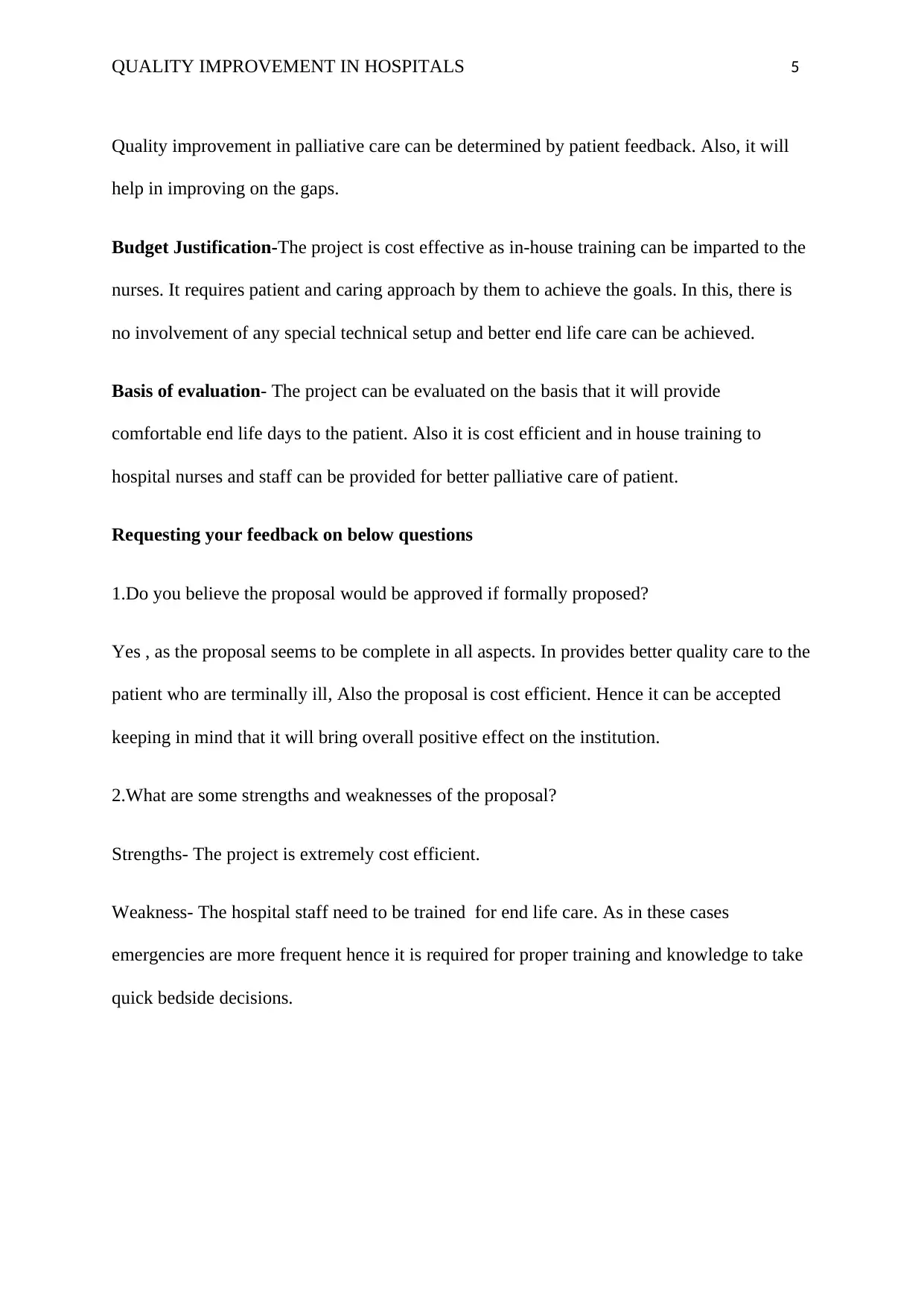
QUALITY IMPROVEMENT IN HOSPITALS 5
Quality improvement in palliative care can be determined by patient feedback. Also, it will
help in improving on the gaps.
Budget Justification-The project is cost effective as in-house training can be imparted to the
nurses. It requires patient and caring approach by them to achieve the goals. In this, there is
no involvement of any special technical setup and better end life care can be achieved.
Basis of evaluation- The project can be evaluated on the basis that it will provide
comfortable end life days to the patient. Also it is cost efficient and in house training to
hospital nurses and staff can be provided for better palliative care of patient.
Requesting your feedback on below questions
1.Do you believe the proposal would be approved if formally proposed?
Yes , as the proposal seems to be complete in all aspects. In provides better quality care to the
patient who are terminally ill, Also the proposal is cost efficient. Hence it can be accepted
keeping in mind that it will bring overall positive effect on the institution.
2.What are some strengths and weaknesses of the proposal?
Strengths- The project is extremely cost efficient.
Weakness- The hospital staff need to be trained for end life care. As in these cases
emergencies are more frequent hence it is required for proper training and knowledge to take
quick bedside decisions.
Quality improvement in palliative care can be determined by patient feedback. Also, it will
help in improving on the gaps.
Budget Justification-The project is cost effective as in-house training can be imparted to the
nurses. It requires patient and caring approach by them to achieve the goals. In this, there is
no involvement of any special technical setup and better end life care can be achieved.
Basis of evaluation- The project can be evaluated on the basis that it will provide
comfortable end life days to the patient. Also it is cost efficient and in house training to
hospital nurses and staff can be provided for better palliative care of patient.
Requesting your feedback on below questions
1.Do you believe the proposal would be approved if formally proposed?
Yes , as the proposal seems to be complete in all aspects. In provides better quality care to the
patient who are terminally ill, Also the proposal is cost efficient. Hence it can be accepted
keeping in mind that it will bring overall positive effect on the institution.
2.What are some strengths and weaknesses of the proposal?
Strengths- The project is extremely cost efficient.
Weakness- The hospital staff need to be trained for end life care. As in these cases
emergencies are more frequent hence it is required for proper training and knowledge to take
quick bedside decisions.
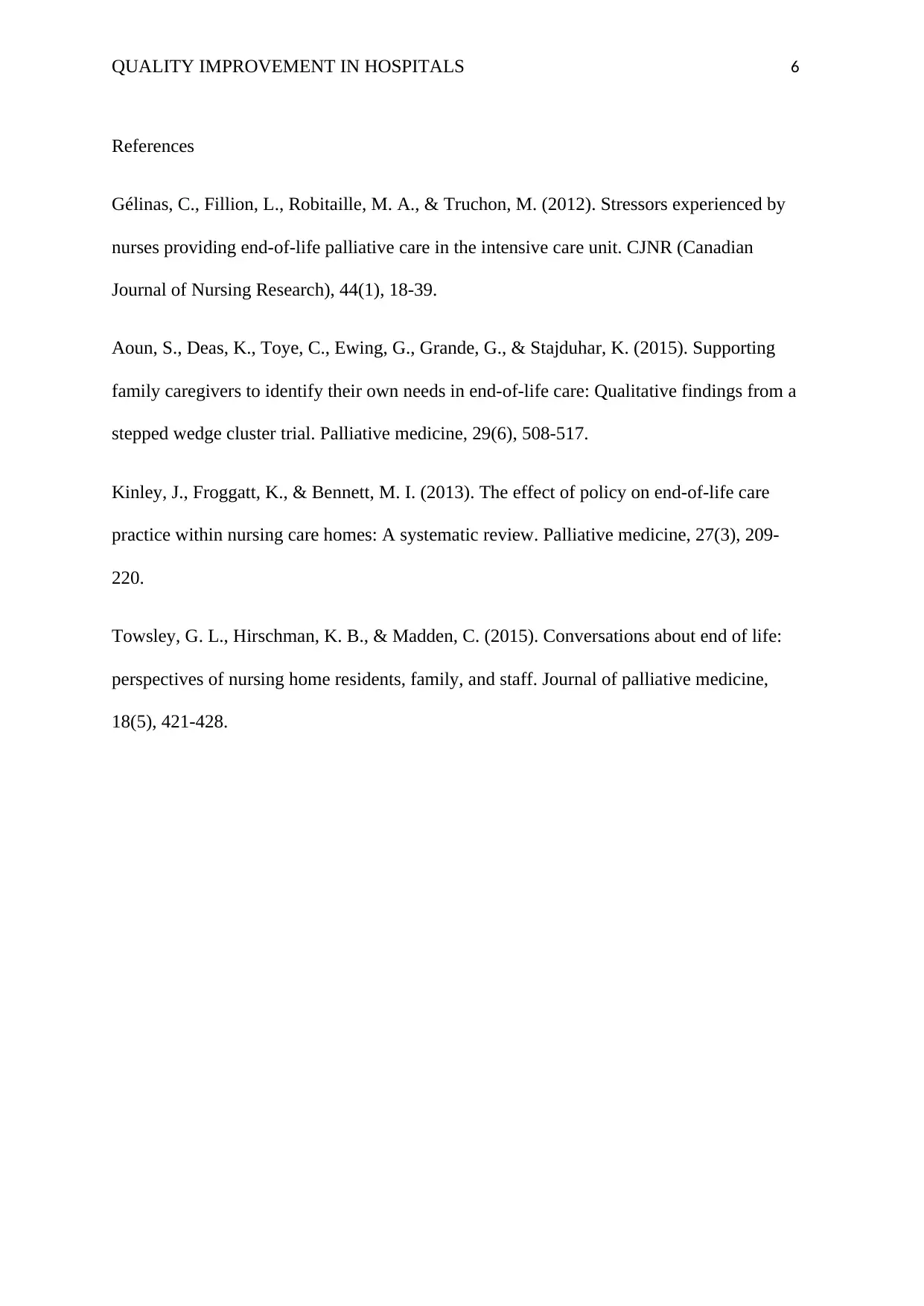
QUALITY IMPROVEMENT IN HOSPITALS 6
References
Gélinas, C., Fillion, L., Robitaille, M. A., & Truchon, M. (2012). Stressors experienced by
nurses providing end-of-life palliative care in the intensive care unit. CJNR (Canadian
Journal of Nursing Research), 44(1), 18-39.
Aoun, S., Deas, K., Toye, C., Ewing, G., Grande, G., & Stajduhar, K. (2015). Supporting
family caregivers to identify their own needs in end-of-life care: Qualitative findings from a
stepped wedge cluster trial. Palliative medicine, 29(6), 508-517.
Kinley, J., Froggatt, K., & Bennett, M. I. (2013). The effect of policy on end-of-life care
practice within nursing care homes: A systematic review. Palliative medicine, 27(3), 209-
220.
Towsley, G. L., Hirschman, K. B., & Madden, C. (2015). Conversations about end of life:
perspectives of nursing home residents, family, and staff. Journal of palliative medicine,
18(5), 421-428.
References
Gélinas, C., Fillion, L., Robitaille, M. A., & Truchon, M. (2012). Stressors experienced by
nurses providing end-of-life palliative care in the intensive care unit. CJNR (Canadian
Journal of Nursing Research), 44(1), 18-39.
Aoun, S., Deas, K., Toye, C., Ewing, G., Grande, G., & Stajduhar, K. (2015). Supporting
family caregivers to identify their own needs in end-of-life care: Qualitative findings from a
stepped wedge cluster trial. Palliative medicine, 29(6), 508-517.
Kinley, J., Froggatt, K., & Bennett, M. I. (2013). The effect of policy on end-of-life care
practice within nursing care homes: A systematic review. Palliative medicine, 27(3), 209-
220.
Towsley, G. L., Hirschman, K. B., & Madden, C. (2015). Conversations about end of life:
perspectives of nursing home residents, family, and staff. Journal of palliative medicine,
18(5), 421-428.
⊘ This is a preview!⊘
Do you want full access?
Subscribe today to unlock all pages.

Trusted by 1+ million students worldwide
1 out of 6
Related Documents
Your All-in-One AI-Powered Toolkit for Academic Success.
+13062052269
info@desklib.com
Available 24*7 on WhatsApp / Email
![[object Object]](/_next/static/media/star-bottom.7253800d.svg)
Unlock your academic potential
Copyright © 2020–2025 A2Z Services. All Rights Reserved. Developed and managed by ZUCOL.





